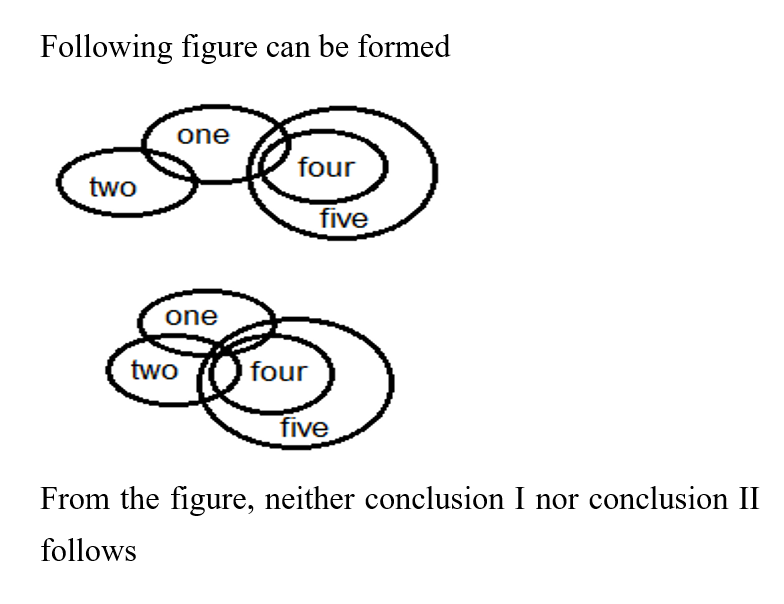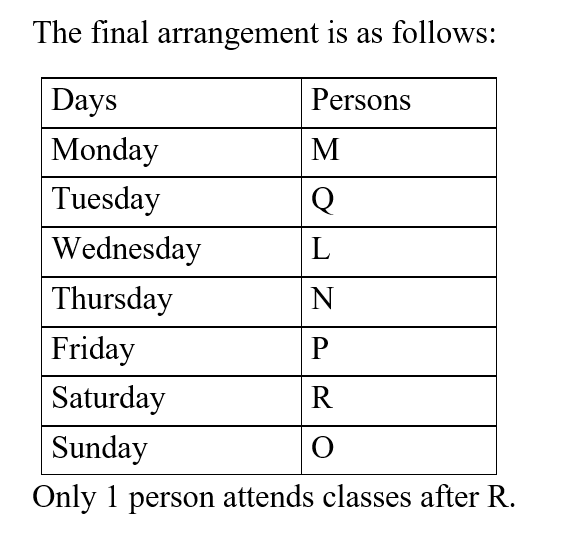Question 1:
Direction: In the question below there are three statements followed by two conclusions I and II. You have to take the three given statements to be true even if they seem to be at variance from commonly known facts and then decide which of the given conclusions logically follows from the three statements disregarding commonly known facts.
निर्देश: निम्नलिखित प्रश्न में तीन कथन के बाद दो निष्कर्ष। और II दिए गए हैं। आपको दिए गए तीनों कथन को सत्य मानना है भले ही वह ज्ञात तथ्यों से भिन्न भी हो और फिर यह तय करना है कि दिए गए निष्कर्षों में से कौन सा निष्कर्ष इन कथनों का तर्कसंगत अनुसरण करता है।
Statements:
Only a few table is chair / कथनः केवल कुछ टेबल चेयर है
A few chair is wood / कुछ चेयर वुड है
All wood is craft / सभी वुड क्राफ़्ट है
Conclusions: / निष्कर्षः
I. Some table is not chair / कुछ टेबल चेयर नहीं है
II. All craft is chair is a possibility / सभी क्राफ़्ट के चेयर होने की संभावना है
Question 2:
Direction: In the question below there are three statements followed by two conclusions I and II. You have to take the three given statements to be true even if they seem to be at variance from commonly known facts and then decide which of the given conclusions logically follows from the three statements disregarding commonly known facts.
निर्देश: निम्नलिखित प्रश्न में तीन कथन के बाद दो निष्कर्ष। और II दिए गए हैं। आपको दिए गए तीनों कथन को सत्य मानना है भले ही वह ज्ञात तथ्यों से भिन्न भी हो और फिर यह तय करना है कि दिए गए निष्कर्षों में से कौन सा निष्कर्ष इन कथनों का तर्कसंगत अनुसरण करता है।
Statements: कथनः
Mostly one is two / अधिकांश वन टू है
Only few four is one / केवल कुछ फोर वन है
Each four is five / प्रत्येक फोर फाइव है
Conclusions: / निष्कर्षः
I. No two is five / कोई भी टू फाइव नहीं है
II. Some four is two / कुछ फोर टू है
Question 3:
Directions: Answer the questions based on the information given below.
निर्देश: दिए गए जानकारी के आधार पर सवालों के उत्तर दें।
Eight persons Ovi, Om, Avi, Anu, Peru, Akki, Oli, and Pihu have different heights.
Peru is taller than two persons. Only Oli and Akki are taller than Avi. Ovi is taller than Pihu, who is taller than Om. Om is not the shortest person. Number of persons taller than Oli is equal to the number of persons shorter than Anu.
आठ व्यक्ति ओवी, ओम, अवि, अनु, पेरू, अक्की, ओली और पिहु की लम्बाई अलग-अलग है।
पेरू दो व्यक्तियों से लम्बा है। केवल ओली और अक्की की लम्बाई अवि से अधिक है। ओवी पिहु से लम्बा है और पिहु ओम से लम्बा है। ओम सबसे छोटा व्यक्ति नहीं है। ओली से लम्बे व्यक्तियों की संख्या और अनु से छोटे व्यक्तियों की संख्या बराबर है।
____ is the 2nd shortest person.
______दूसरा सबसे छोटा व्यक्ति है।
Question 4:
Directions: Answer the questions based on the information given below.
निर्देश: दिए गए जानकारी के आधार पर सवालों के उत्तर दें।
Eight persons Ovi, Om, Avi, Anu, Peru, Akki, Oli, and Pihu have different heights.
Peru is taller than two persons. Only Oli and Akki are taller than Avi. Ovi is taller than Pihu, who is taller than Om. Om is not the shortest person. Number of persons taller than Oli is equal to the number of persons shorter than Anu.
आठ व्यक्ति ओवी, ओम, अवि, अनु, पेरू, अक्की, ओली और पिहु की लम्बाई अलग-अलग है।
पेरू दो व्यक्तियों से लम्बा है। केवल ओली और अक्की की लम्बाई अवि से अधिक है। ओवी पिहु से लम्बा है और पिहु ओम से लम्बा है। ओम सबसे छोटा व्यक्ति नहीं है। ओली से लम्बे व्यक्तियों की संख्या और अनु से छोटे व्यक्तियों की संख्या बराबर है।
How many persons are taller than Pihu?
Question 5:
Directions: Study the given arrangement of numbers and symbols and answer the questions based on it.
निर्देश: दिए गए संख्याओं और प्रतीकों के व्यस्था का ध्यानपूर्वक अध्ययन करें और सवालों के उत्तर दे।
4 @ % 8 7 9 $ 1 ^ 2 & 1 3 9 & 0 % ! 7 5 * 5 8 ® 6 €
35. How many such symbols are there in the given arrangement which are immediately followed and preceded by odd numbers?
दिए गए व्यवस्था में ऐसे कितने प्रतीक हैं जिनके तत्काल बाद और तत्काल पहले एक विषम संख्या है?
Question 6:
Directions: Study the given arrangement of numbers and symbols and answer the questions based on it.
निर्देश: दिए गए संख्याओं और प्रतीकों के व्यस्था का ध्यानपूर्वक अध्ययन करें और सवालों के उत्तर दे।
4 @ % 8 7 9 $ 1 ^ 2 & 1 3 9 & 0 % ! 7 5 * 5 8 ® 6 €
How many odd numbers are there which are immediately followed by even number but not immediately preceded by odd numbers?
ऐसे कितने विषम संख्या है जिनके तत्काल बाद सम संख्या है पर तत्काल पहले एक विषम संख्या नहीं है?
Question 7:
Directions: Study the given arrangement of numbers and symbols and answer the questions based on it.
निर्देश: दिए गए संख्याओं और प्रतीकों के व्यस्था का ध्यानपूर्वक अध्ययन करें और सवालों के उत्तर दे।
4 @ % 8 7 9 $ 1 ^ 2 & 1 3 9 & 0 % ! 7 5 * 5 8 ® 6 €
What is sum of the numbers which are there in between ^ and ® in the given arrangement?
दिए गए व्यवस्था में ^ और ® के बीच की संख्याओं का योग कितना है?
Question 8:
Directions: Answer the questions based on the information given below.
निर्देश: दिए गए जानकारी के आधार पर सवालों के उत्तर दें।
Seven persons, L, M, N, O, P, Q and R attend classes on different days in the same week (Monday-Sunday).
One person attends the class before Q. N is the 3rd person, who attends the classes before O. N attends the classes after Q. One person attends the classes between L and P. M attends the classes before L. At least three persons attend the classes between M and R. L doesn’t attend on Friday.
सात व्यक्ति, L, M, N, O, P, Q और R एक सप्ताह में सोमवार से रविवार तक भिन्न भिन्न दिनों में एक कक्षा में उपस्थित होते हैं।
एक व्यक्ति Q से पहले कक्षा में उपस्थित होता है। NO के पहले कक्षा में उपस्थित होने वाला तीसरा व्यक्ति है। NQ के बाद कक्षा में उपस्थित होता है। एक व्यक्ति L और P के बीच कक्षा में उपस्थित होता है। ML के पहले कक्षा में उपस्थित होता है। M और R के बीच कम से कम तीन व्यक्ति कक्षा में उपस्थित होते हैं। शुक्रवार को उपस्थित नहीं होता है।
How many persons attend classes after R?
R के बाद कितने व्यक्ति कक्षा में उपस्थित होते हैं?
Question 9:
Directions: Answer the questions based on the information given below.
निर्देश: दिए गए जानकारी के आधार पर सवालों के उत्तर दें।
Seven persons, L, M, N, O, P, Q and R attend classes on different days in the same week (Monday-Sunday).
One person attends the class before Q. N is the 3rd person, who attends the classes before O. N attends the classes after Q. One person attends the classes between L and P. M attends the classes before L. At least three persons attend the classes between M and R. L doesn’t attend on Friday.
सात व्यक्ति, L, M, N, O, P, Q और R एक सप्ताह में सोमवार से रविवार तक भिन्न भिन्न दिनों में एक कक्षा में उपस्थित होते हैं।
एक व्यक्ति Q से पहले कक्षा में उपस्थित होता है। NO के पहले कक्षा में उपस्थित होने वाला तीसरा व्यक्ति है। NQ के बाद कक्षा में उपस्थित होता है। एक व्यक्ति L और P के बीच कक्षा में उपस्थित होता है। ML के पहले कक्षा में उपस्थित होता है। M और R के बीच कम से कम तीन व्यक्ति कक्षा में उपस्थित होते हैं। शुक्रवार को उपस्थित नहीं होता है।
____ attends classes on Friday.
______ शुक्रवार को कक्षा मेंउपस्थित होता है।
Question 10:
Directions: Answer the questions based on the information given below.
निर्देश: दिए गए जानकारी के आधार पर सवालों के उत्तर दें।
Seven persons, L, M, N, O, P, Q and R attend classes on different days in the same week (Monday-Sunday).
One person attends the class before Q. N is the 3rd person, who attends the classes before O. N attends the classes after Q. One person attends the classes between L and P. M attends the classes before L. At least three persons attend the classes between M and R. L doesn’t attend on Friday.
सात व्यक्ति, L, M, N, O, P, Q और R एक सप्ताह में सोमवार से रविवार तक भिन्न भिन्न दिनों में एक कक्षा में उपस्थित होते हैं।
एक व्यक्ति Q से पहले कक्षा में उपस्थित होता है। NO के पहले कक्षा में उपस्थित होने वाला तीसरा व्यक्ति है। NQ के बाद कक्षा में उपस्थित होता है। एक व्यक्ति L और P के बीच कक्षा में उपस्थित होता है। ML के पहले कक्षा में उपस्थित होता है। M और R के बीच कम से कम तीन व्यक्ति कक्षा में उपस्थित होते हैं। शुक्रवार को उपस्थित नहीं होता है।
How many persons attend the classes between L and O?
L और O के बीच कितने व्यक्ति कक्षा में उपस्थित होतेहैं?





